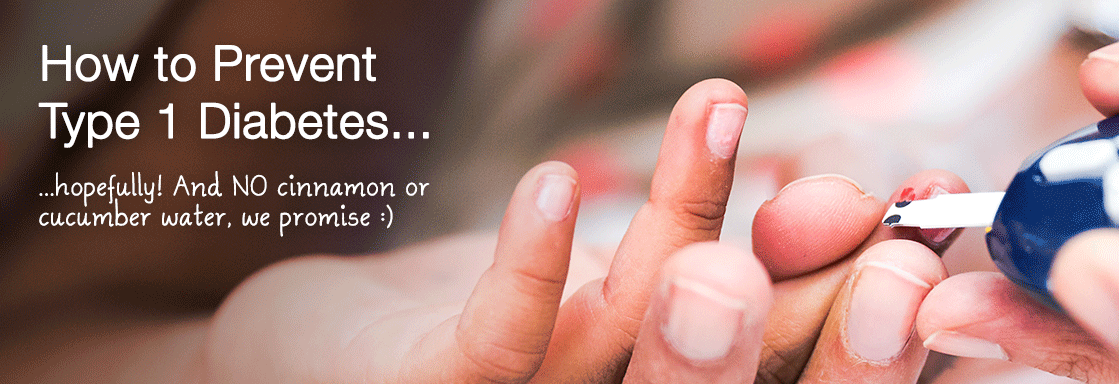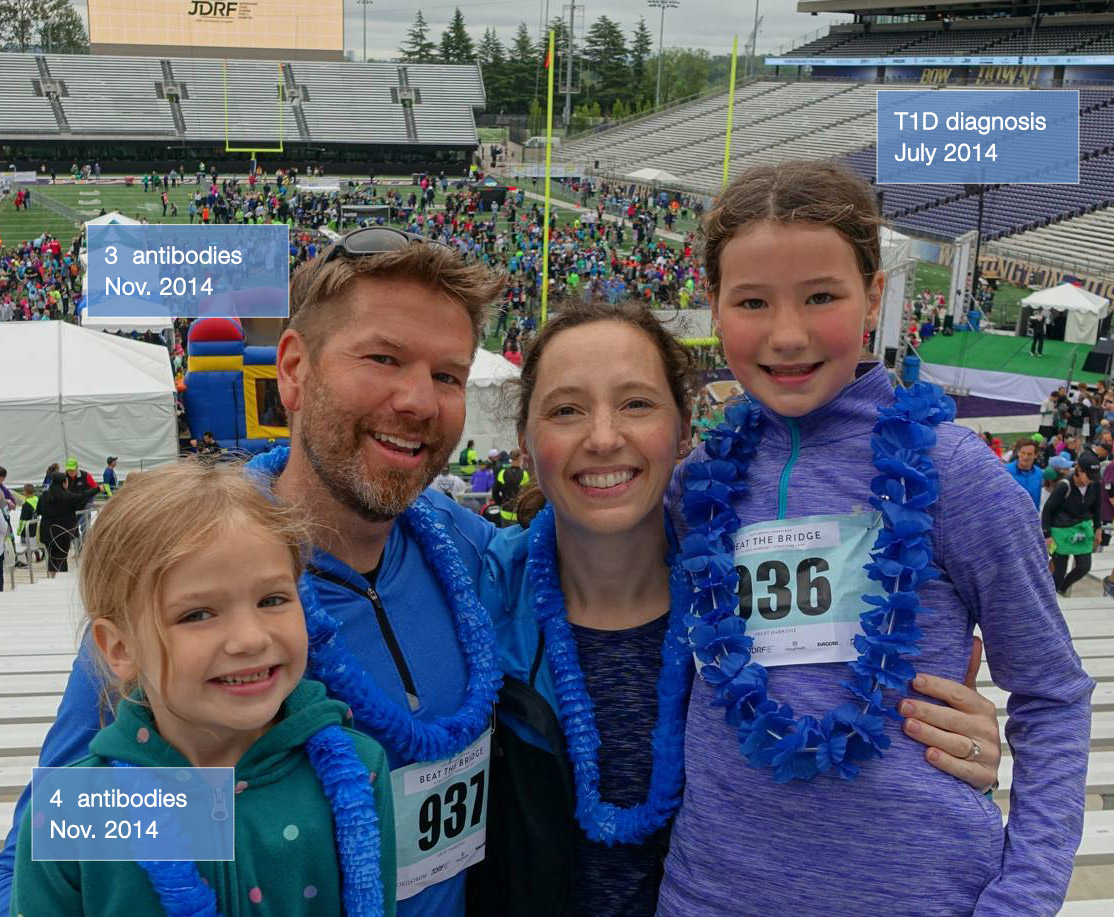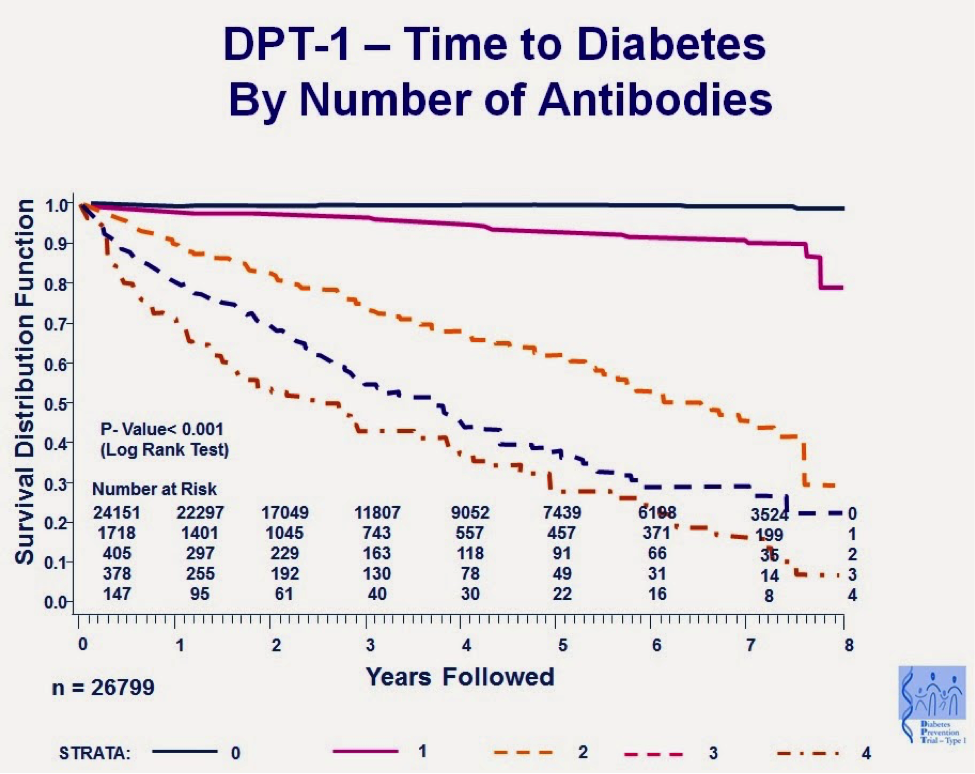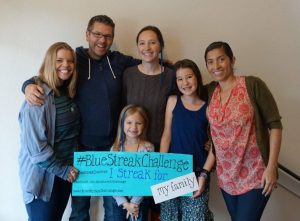
Scroll or jump to the end of the page for an update on prevention research, and information on how to participate.
First the disclaimers: I’m not a medical doctor and I cannot give you medical advice and nothing here should be construed as medical advice, blah, blah, etc. That said, if you’re anything like me and my family and are facing the likelihood of Type 1 Diabetes onset, you’re willing to try just about anything to prevent that from happening. What you’ll read below has been our experience and the reported experience of others.
Also, we’ve all seen Internet marketing sites that tease you with the promise of curing Type 1 Diabetes (cinnamon!), curing cancer (superfoods!), lose belly fat in 10 days (grapefruit!). All that stuff. What all those sites have in common is that to “learn more” they either want you to sign up with an email address or pay to get their e-book. That’s not the case here. We’re giving you all the information that we have with no affiliate links anywhere. We are not interested in profiting from this information; we want to give back to the awesome and supportive Type 1 Diabetes community.
No guarantees. At this point, anybody who says they can guarantee a cure for type I diabetes is selling you something. That said: if you’re in our boat, you’re willing to try anything (that’s safe) and the anecdotal stories I got from Sonia Chritton (Children with Diabetes Research Foundation, CWDRF) and our own early tests are incredibly positive! I didn’t want to get my hopes up too high and was hoping to delay onset but right now I think we might be able to actually prevent it; time will tell but I’ve got my fingers crossed.
Lastly, to the skeptics and naysayers: the whole point of the #WeAreNotWaiting is that families are not content to sit idly by and do nothing for better treatment for our loved ones. Currently, when someone tests positive for antibodies, they are told there is nothing they can do to delay or prevent the onset of Type 1 Diabetes. It is an incredibly frustrating and awful feeling to know that the diagnosis is looming and waiting out there. The information below may not have been vetted in double-blind studies, and it may be too much of a scattershot/shotgun approach to be able to drill down on the actual effective pieces. But given the other positive experiences I’ve heard about, my family’s positive experiences, having done what we’ve done so far, and what to me is common sense, I am willing to bet many other folks would be willing to try, investigate, or research just like we did. It seemed really wrong to us that someone with four markers should be told that diet doesn’t impact diagnosis at all and the kids should continue to the eat gluten, drink dairy, go to 7-Eleven and get Slurpees; that just doesn’t make sense to me. #WeAreNotWaiting to try to stall the onset of T1D.
So I’ll give you the full saga here so that you know what our history is and see if it lines up with yours at all. My oldest daughter was diagnosed with T1D in the summer of 2014 and as part of acclimating to Type 1 Diabetes life, we went to a diabetes camp that had TrialNet screening. And being good citizens, we decided to submit our blood. At no point did we think that anything would come of it.
Fast-forward three months, and I got a call from TrialNet letting me know that my youngest had four of the five antibodies, and on top of that I (the dad) had three of the five markers. At this point, I freaked out. Wouldn’t you? Maybe you already have. So about a year and a half ago I started looking for ways to delay or prevent the onset of Type 1 Diabetes. Researchers and Endocrinologists both said there was nothing to do. They told us that there was no proven way to stop the onset of Type 1 Diabetes. And if you have seen the timeline for people developing Type 1 Diabetes based on the number of markers they have (shown below, or read more from Joshua Levy), you’d know that we were looking at as little as a year or two for my youngest and myself to be diagnosed. Not great news.


Dr. Jody had us following this protocol, along with a low-grain, low-carb diet to reduce stress on the beta cells (elevated blood sugars are alone damaging to the beta cells). This includes low/no intake of gluten and dairy, as their intake has been associated with an increase in autoimmune reactivity. We also eliminated food where a person had a high sensitivity to it.
Around this time my youngest and I went to TrialNet and did an Oral Glucose Tolerance Test (OGTT) and at that time, she tested abnormal finishing the two hours out at 149. I tested normal for the whole thing.
Fast-forward another six months, and my daughter and I go back to TrialNet to do another OGTT. This time my daughter tested abnormal again as she finished out the two hours at 169 and I tested abnormal because I got over 200 at the 30 minute mark. Following that, my daughter and I both wore Dexcom CGMs for a week and a half long. And during that time my daughter without Type 1 Diabetes would get up to 220 to 240 at night (after visiting Grandma and Grandpa’s for a decently carb-heavy meal). I, also, went above 200 for a few hours following said carb-heavy meals.
So based on my expectations at that point (and the chart shown above), I figured we had maybe a year to a year and a half before one of us was diagnosed with Type 1 Diabetes. And I freaked out again because the prospect of having multiple family members fighting this disease wasn’t super exciting. So I did another round of research and put out multiple pleas on CGM in the Cloud asking folks about anything that might help delay the onset: didn’t have to be proven I just wanted to try things. I also started doing a lot of research into promising trials that were showing the effects of different supplements and drugs that have helped with autoimmune issues.
Read more from Sonia Chritton, on her son Ben’s Story About Trying to Prevent Diabetes.
Luckily for me, someone on CGM in the Cloud reached out to me privately and connected me with Sonia Chritton, who played a significant role in the Type 1 Diabetes community and research. She has a son with Type 1 Diabetes, she has another son that had tested positive for multiple autoanitbodies that they were testing for the time, and she also tested autoantibody positive. She freaked out, too! She reached out to all of her researcher friends and asked them if they were in her shoes what they would do. With their help, she developed a cocktail of different vitamins and supplements that she has since been recommended to dozens of other people in the same situation as ours. In all cases the people did not develop Type 1 Diabetes while on the “cocktail”. One girl eventually became diabetic about 5 years later, but she had gone off to college and went off the cocktail. At least she had a delay. Her brother and father and others in the family have T1D. Sonia recommended that we study the work of Charlie Serhan of Harvard, and you can see all of his research around anti-inflammatory diseases and DHA. We were also given other recommended readings by researchers who are experts in nutritional epidemiology and inflammation to include Dr. Lars Stene, and the Principal Investigators for the Nutritional Intervention to Prevent (NIP) study – Dr. H. Peter Chase and Dr. Michael Clare-Salzler. Where we got recommendations to specific products I’ve added links to Amazon for ease, but purchase them wherever you like.
The new “cocktail” recommended to us by Sonia Chritton is as follows:
So we upped our supplement game again, stretching the wallet a bit, and again willing to do whatever it took to delay or prevent Type 1 Diabetes. Both my daughters and I started taking this new combined cocktail of everything. (We have my T1D doing all this as well to help preserve her beta cells, and here we are at two years since diagnosis and she is still honeymooning. Given that, it seems clear that Dr. Jody’s vitamin list alone has definitely been working as expected.)
Here’s an example of what we do, based on a 150 lb. adult, for the supplement routine with its’ approximate cost per day. A few important notes:
| Supplement | AM dose example | PM dose example | Cost / day |
|---|---|---|---|
| DHA | 1500mg | 1500mg | $1.32 |
| Low-dose aspirin | 81mg | 81mg | $0.03 |
| Vitamin D | 5000 IU ** | $0.04 | |
| Bio Gymnema | 1 Capsule | $0.34 | |
| Cytozyme Pancreatic Glandular | 1 Tablet | 1 Tablet | $0.56 |
| Green Tea Extract | 1 Capsule | $0.06 | |
| Probiotic | 1/4 Tsp | 1/4 Tsp | $0.89 |
| Glutagenics | 1 Tsp | $0.93 | |
| Multi-vitamin | See packaging | $0.60 | |
| OUR DAILY COST | $4.75 | ||
Fast-forward another six weeks, and we throw another CGM on my non-T1D. She wears it for a week and we can see her spiking sometimes up to about 150 – 160 but never above that and only for the briefest of moments; rather than sustaining elevated blood sugars for hours. We wanted to really put things to the test and see if they were different so we created a giant carb fest for her:
And what did we see? That she got up to 205 but then immediately came down and I mean it was one reading and she came right down! This was amazing and huge for us! Before she was getting over 240 and staying there for hours, and now we couldn’t get her over 205 (for 5 minutes) trying as hard as we could. It says to me, that the massive amount of vitamins and supplements we are taking our working. We will most likely do another test in two or three months with the CGM and see what we find there.
Given the timeline for as many markers as she and I had, my biggest hope was to delay the onset by a year or two if we could because technology and research keeps moving so fast. I now actually have hope for the first time since getting that call from TrialNet that we might be able to keep the number of T1D’s in the house down to one (and hopefully eventually none).
What we found interesting is that there are numeric values associated with each one of the markers (something I had no idea about until we requested our lab values from TrialNet); these are called titres. In looking at our results from our initial TrialNet submissions to the two OGTTs that we took, my youngest and my values associated with each one of those antibodies have been dropping. Our non-T1D daughter even dropped one anitbody and is now positive for the same three that I am. I credit all of that entirely to Dr. Jody and the work that she did with us, as we had not gotten on the revised cocktail until after our last OGTT.
Sonia suggested that we ask for our genetic markers to learn more about risk. Her son with T1D has a DR3/DR4 combination. She knows the high risk of her other kids. You get one allele from each parent, and because her kids are enrolled in DAISY, they are open and honest about the genetics. TrialNet should be encouraged to do the same. Hey, we are the families helping them gather information, shouldn’t we be entitled to full disclosure of our own results?
Below you can see our latest antibody results and see that some of the titres have dropped and some have come back up a little bit. We are going to be tweaking the cocktail a bit more to see if we can continue to find improvements.
However, if you look at the results of the OGTT you can see some marked improvement in one of us:
The reason that researchers haven’t publicized a lot about this is that the cocktail is a shotgun approach and no one can say what piece or pieces are truly effective. It’s also very involved, expensive, and you are taking a lot of different vitamins and supplements. But if you’re in our shoes, and maybe your shoes, you don’t really care you just want it to work. I’m not promising that it will work for you, and I was skeptical because it seems too good to be true, but so far all of our tests indicate that things are headed in the right direction. On that basis alone I wanted to share this information with the rest of the Type 1 Diabetes community; because I know there are other families that might be desperate for this information as well.
I think that the reason this cocktail works is that it suppresses inflammation through the combination of Omega-3 Docosahexaenoic acid (DHA) and the Vitamin D and aspirin (if you decide to try that). Additionally, by eliminating dietary elements which cause inflammation (dairy and gluten). The “Cocktail” also encourages anti-oxidants, particularly a multi-vitamin with zinc and powerful boosters like alpha lipoic acid and green tea capsules.
The evidence for putting other autoimmune diseases into remission with high dose DHA is significant. You can certainly see this with Lupus and Rheumatoid Arthritis, and there is even a use for DHA with unrelated challenges such as post-partum depression and ADHD.
Unfortunately, you have to take this cocktail for as long as you don’t want Type 1 Diabetes or until there’s a cure. Sonia’s son has gone off the cocktail multiple times, had markers return, and then gone back on the cocktail to remove the markers. He’s lucky in that he’s been able to get rid of his markers every time they returned. I wish there was a one-time solution but I am willing to take a handful of pills multiple times a day to avoid a diagnosis of T1D.
There are a couple other things I was considering doing based on the research I found in delaying Type 1 Diabetes…
At this point, since neither my non-T1 D daughter nor myself are going over 150 for more than a few minutes, it doesn’t look like we need to do this now but I was open to it when things looked a bit bleaker. Again, anything to prevent Type 1 Diabetes.
Thanks for reading if you got this far!
The Pressnalls (you can reach us through [email protected])
PS Join the FB Group we set up to allow the conversation to continue:
https://www.facebook.com/groups/146192649180257/
October 11, 2018
We were invited to participate in the first ever Type One Diabetes Prevention Summit this April 20th, 2018 down in Miami. World-renowned experts including Dr. Michael Clare-Salzler, Dr. Camillo Ricordi, and researchers from JDRF were there to talk about ways to prevent or delay the onset of autoimmune diseases like T1D.
https://www.youtube.com/watch?v=60BzRAuIImc
https://www.youtube.com/watch?v=JLdlwmVtyuY&feature=youtu.be&t=4112
https://www.youtube.com/watch?v=2k-41D69LUo
Red is Person 1. Blue is Person 2. They sometimes go up as we don’t conform to the protocol as best as we can (read this as: Life Happens!) but you can see an overall improvement of our values.
The big news coming out of the conference is that Dr. Ricordi worked to get the POSEIDON trial off the ground!
Sonia Critton also obtained IRB approval for a prevention trial in partnership with GrassrootsHealth. You can enroll online and the test kit will be mailed to you to complete at home. Scholarships are available to those who have been identified as being at risk for developing T1D, by having tested positive for one or more of the known islet autoantibodies for T1D.
T1D sucks but we are incredibly lucky to have champions like Sonia Chritton, Michael Clare-Salzler, and Cami Ricordi fighting to provide families the best options available to us. My family is incredibly thankful for them and all they do!
Please research and if you want to join us, start by visiting:
https://www.facebook.com/groups/preventautoimmunedisorders/
And if you are the type that doesn’t want to wait for better blood sugar control and want to keep your T1D family members safe, check out OpenAPS or Loop. Both solutions are discussed in the Facebook group, Looped, as well.
This video shows you what it can do for you:
Please share your thoughts and comments below and definitely please share this out on Facebook or with other folks that you think might benefit from this information.
If you have been on your own “cocktail”, this is the place to share your story. We have researchers who hope to put together a protocol and this will be shared! They need evidence, even if it is anecdotal, to support a large NIH effort to prevent and cure T1D!


The #BlueStreakChallenge brings attention to Diabetes Awareness Month. A streak of blue in your hair is a conversation starter and lets other families with Diabetes know that others are supporting them.